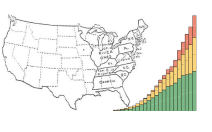The first decennial census of population in the United States was taken in 1790, reflecting the constitutional requirement (Article I, Section 2) that an enumeration be conducted every ten years for use in apportioning members of the House of Representatives among the states. The information collected was tallied by household and included five items in addition to the name of head of the household: the numbers of persons who were White males 16 years and over, White males under age 16, White females, other free persons, and slaves.[1]
During the following two centuries, the items on the census of population were expanded to include a wide range of social and economic characteristics. Starting in 1850, information was collected for each person (rather than by household), permitting the addition of items with a large number of possible responses, such as place (state or foreign country) of birth and occupation. The census of housing, conducted in conjunction with the census of population, was introduced in 1940, although information on household tenure (owner/renter) had been collected previously in the census of population. The many changes in the decennial census in addition to content included the introduction of electrical tabulating machines in 1890, sampling in 1940, electronic computers in 1950, and the gradual replacement of door-to-door enumerators with mail-out, mail-back data collection from 1960 to 1980. Starting in 1880, the decennial census has been taken under some provision for confidentiality. The decennial census is currently taken under Title 13, U.S. Code, which requires that the Census Bureau release no data that would permit the identification of any person or household.[2]
Data from the decennial census of population were published in printed reports starting with a single 56-page report for 1790 and surpassing 100,000 pages for 1960, when data were first made available also on computer tape files. In general, the increase reflected the increase in the amount of data collected, the quantity of cross-tabulations produced, and the geographic detail for which the data were published. The Census Bureau Internet site (www.census.gov) has supplanted printed reports as the primary medium for releasing census data, and printed pages were reduced to about 50,000 in just three report series for 2000.
While many of the older printed reports from the decennial census are not readily available, most of these publications for the 1790 to 2000 period are now available on the Census Bureau Internet site. In addition, two other major sources for historical census data merit description here. The first of these is the five-volume Historical Statistics of the United States: Millennial Edition, hereafter referred to as Millennial Edition.[3] It was produced by an academic consortium and supersedes editions of Historical Statistics of the United States published by the Census Bureau in 1949, 1960, and 1975.[4] The Millennial Edition facilitates the use of historical data by presentation in time series format, and in the case of decennial census data in particular, includes data at the regional and state levels as well as the national level on several topics.
The second of these additional sources is the Integrated Public Use Microdata Series (IPUMS), which combines microdata files produced by the Census Bureau since 1960 with representatives samples drawn from census schedules for the 1850 to 1950 period., excluding 1890 (destroyed by fire in 1921) and 1930 (under development). IPUMS (www.ipums.umn.edu) permits the development of time series with a consistent set of classifications on topics for which the census classifications have changed over time (e.g., occupation) and/or which were not tabulated at each census in which the underlying data were collected (e.g., households by size). Many time series of decennial census data based on IPUMS are included in the Millennial Edition.[5]
As suggested by the preceding description, there is a tremendous quantity of data available based on the decennial census of population. In addition, there is extensive scholarly analysis of American demographic history based on the census and other sources of demographic information.[6] These other sources include, for example, administrative data on vital statistics (births, deaths, marriage, and divorce) and immigration, and national survey data since the 1940s on a wide range of social and economic characteristics.
The purpose of the American Demographic History Chartbook is to present basic information about demographic trends and differentials in the United States in the 1790 to 2000 period, as revealed by the decennial census of population, and to do so using graphics designed for a general audience of persons interested in U.S. history. In keeping with the stated purpose and general audience, the Chartbook has been kept relatively short. Those persons interested in more detail on any of the topics included here may consult References, which are divided into Decennial Census Publications and References Other than Decennial Census Publications.
[1]Bohme et al, 1973.
[2]Bohme et al, 1973; Anderson, 1988; Gauthier, 2002. The requirement for confidentiality is 72 years, after which period microfilm copies of decennial census schedules are available to the public from the National Archives, pursuant to Title 44. U.S. Code..
[3]Carter, Gartner, Haines, Olmstead, Sutch, and Wright, editors in chief, 2006.
[4]For simplicity, the term Census Bureau is used in the text to include its predecessors, the Bureau of the Census and the Census Office. See References, Decennial Census Publications.
[5]For a description of IPUMS, see Ruggles, Sobek, et al, 1997.
[6]The essays in the Millennial Edition, along with the references provided in these essays, provide an extensive analysis of American demographic history. See especially, Carter, Haines, Sutch, and Wright, 2006; Haines, 2006a; Haines, 2006b; Ferrie, 2006; Barde, Carter, and Sutch, 2006; Ruggles, 2006; Carter, 2006; and Sobek, 2006. For a one-volume “survey” of American demographic history, see Klein, 2004. For demographic methods and techniques of analysis, see one of the editions of The Methods and Materials of Demography, the first and the most recent editions being Shryock, Siegal, and Associates, 1971; and Siegal and Swanson, editors, 2004.
